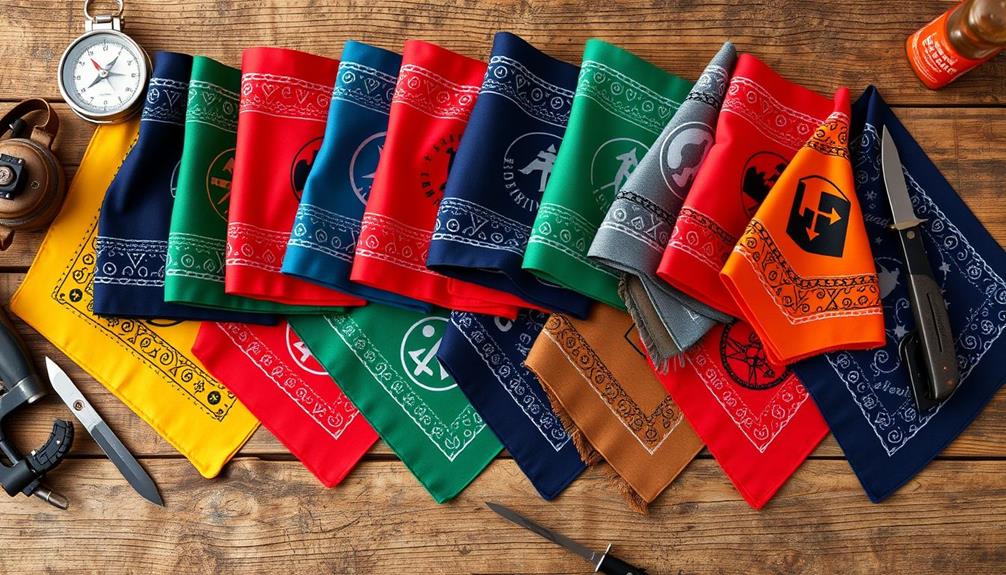Mastering fire skills is vital for your survival in the wild. It gives you warmth, cooks food, and purifies water, making it your lifeline. To succeed, gather essential gear like waterproof matches and dry tinder. Choose the right location and structure your fire to promote airflow. Keep safety in mind—always monitor your flames and have water ready. Practice in various weather conditions to build your confidence and adaptability. With time and persistence, you'll ignite a fire with ease. There's much more to explore on creating the perfect flame and ensuring your safety in any survival situation.
Key Takeaways
- Gather essential fire-making gear, including waterproof matches, dry tinder, and kindling for successful ignition and sustained burning.
- Familiarize yourself with various fire-starting techniques, such as using a fire rod or friction methods, to adapt to conditions.
- Choose a safe, clear area for building your fire, considering wind direction and potential wildfire hazards to ensure safety.
- Experiment with different fire structures like teepees and log cabins to enhance airflow and improve ignition success.
- Practice in various weather conditions to build confidence and adaptability in your fire-making skills for survival situations.
Importance of Fire in Survival

Fire is essential for survival in the wilderness, as it serves multiple vital functions.
It provides warmth, keeping you safe from the chilling effects of cold nights. You can cook food and purify water, making what you consume safer and more nutritious.
Fire also acts as a protective barrier against wildlife and insects, giving you peace of mind. Psychologically, it boosts your morale and fosters a sense of community if you're with others.
Additionally, it can signal for help, increasing your chances of rescue.
Finally, fire allows you to create tools and craft materials, enhancing your survival capabilities.
Embrace fire's significance, and you'll greatly improve your chances of thriving in the wild.
Essential Gear for Fire Making

To successfully harness the power of fire in survival situations, you'll need the right gear to guarantee you can ignite and maintain a flame.
Start with a firestarter kit, including waterproof matches, lighters, and tinder. A fire rod is essential for producing sparks, even in damp conditions. Stormproof matches are a must for harsh weather.
Gather dry, easily ignitable tinder like dry leaves or cotton balls. Don't forget kindling—small sticks and twigs that help shift to larger fuel sources.
Always carry ample fuel, such as dry wood or fire logs. A portable fire pit or metal container guarantees safety, and a fire blanket can help extinguish small fires.
With this gear, you're well on your way to mastering fire skills.
Techniques for Successful Fire Starting

When you're ready to start a fire, selecting the right materials is key for success. Choose dry, fluffy tinder, and construct your fire in a structure that promotes airflow, like a teepee or log cabin. Here's a quick reference to help you visualize your materials:
| Material Type | Purpose | Examples |
|---|---|---|
| Tinder | Quick ignition | Dry leaves, cotton balls |
| Kindling | Flame support | Small sticks, twigs |
| Fuel | Sustained burning | Logs, large branches |
Ensure adequate spacing between materials to allow oxygen circulation. Familiarize yourself with various fire-starting techniques, such as using a fire rod, friction methods, or traditional matches. The right approach can make all the difference!
Fire Safety and Management

Starting a fire is only part of the equation; managing it safely is just as important. Always clear a space around your fire to prevent wildfires, and use a fire ring or designated area whenever possible.
Keep water or soil nearby to extinguish flames quickly if needed. Pay attention to wind direction, as it can spread flames unexpectedly.
Never leave a fire unattended—this is essential for safety. Make sure to completely extinguish your fire before leaving the area, ensuring no embers remain.
Familiarize yourself with local fire regulations to avoid any legal issues while camping. By prioritizing fire safety and management, you protect both yourself and the environment, making your survival experience safer and more enjoyable.
Planning for Fire Success

Planning for fire success involves careful consideration of various factors to guarantee you can ignite and maintain a fire effectively. Start by evaluating your environment and understanding the conditions that may affect your fire. Here's a quick reference table to help you visualize your planning:
| Factor | Considerations |
|---|---|
| Weather | Check humidity and wind direction |
| Materials | Gather dry tinder, kindling, fuel |
| Location | Choose a safe, clear area |
| Purpose | Define if for warmth, cooking, etc. |
Building Confidence in Fire Skills

Building confidence in fire skills comes from practice and familiarity with various techniques. Start by gathering essential gear like waterproof matches, dry tinder, and kindling.
Experiment with different fire structures, such as teepees and log cabins, to see which works best for you. Regularly practice in various conditions—windy, humid, or dry—to adapt your approach and understand how different environments affect your fire-making success.
Each attempt, whether successful or not, will teach you valuable lessons. Join a group or take a class to learn from others' experiences, enhancing your knowledge and skills.
The more you practice, the more comfortable you'll feel, transforming fire-making from a challenging task into a reliable survival skill. Embrace the challenge and ignite your confidence!
Adapting Fire Skills to Conditions

Adapting fire skills to different environmental conditions is essential for guaranteeing success in survival scenarios. This means understanding how to create and maintain a fire in both wet and dry conditions, as well as in high altitudes or windy environments. In some cases, relying on tools like essential survival stoves for camping can make all the difference, offering a reliable heat source when natural materials are scarce or damp. Mastering these techniques and having the right equipment ensures preparedness for any challenge the wilderness presents.
In wet or humid areas, seek dry materials like bark or sapwood for tinder, and utilize a fire rod to generate sparks.
If you're in windy conditions, create a windbreak using rocks or logs to protect your flames.
For high altitudes, where oxygen is thinner, you might need to adjust your fire structure to guarantee proper airflow.
Always assess the ground's dryness and clear debris to prevent wildfires.
In cold weather, build a fire close to your shelter but maintain a safe distance.
Frequently Asked Questions
What Are Common Fire-Starting Mistakes to Avoid?
When starting a fire, avoid using damp materials, overcrowding your setup, or neglecting airflow. Don't underestimate wind direction, and always guarantee you have enough tinder and kindling for a successful ignition. Practice makes perfect!
How Can I Find Tinder in Different Environments?
Finding tinder's like a treasure hunt! In forests, look for dry leaves or moss; in deserts, search for dead grass or cactus fibers; near rivers, grab twigs and bark. Always keep your eyes peeled!
What Are the Best Fire-Starting Methods for Wet Conditions?
In wet conditions, use a fire rod for sparks, and gather dry tinder like birch bark. Construct a teepee structure with kindling, ensuring airflow, and keep fuel off the ground to stay dry.
How Do I Safely Extinguish a Fire in an Emergency?
You might think extinguishing a fire is simple, but it's not. So, douse it with water, stir the ashes, and guarantee no embers remain. Always check twice; safety's key in any emergency.
Can I Use Alternative Materials for Fire Starting?
Yes, you can use alternative materials for fire starting. Items like dryer lint, cotton balls, or even pine needles can ignite effectively. Just make certain they're dry and fluffy to promote quick combustion when paired with a proper tinder.
Conclusion
As you stand by a crackling fire under a starlit sky, let its warmth remind you of the life-saving power you hold. Just like a lone ember can spark a roaring blaze, your newfound fire skills can ignite confidence and resilience in the wild. Remember, mastering fire isn't just about survival; it's about creating a beacon of hope and camaraderie. Embrace these skills, and you'll light up your adventures, turning challenges into cherished memories.










